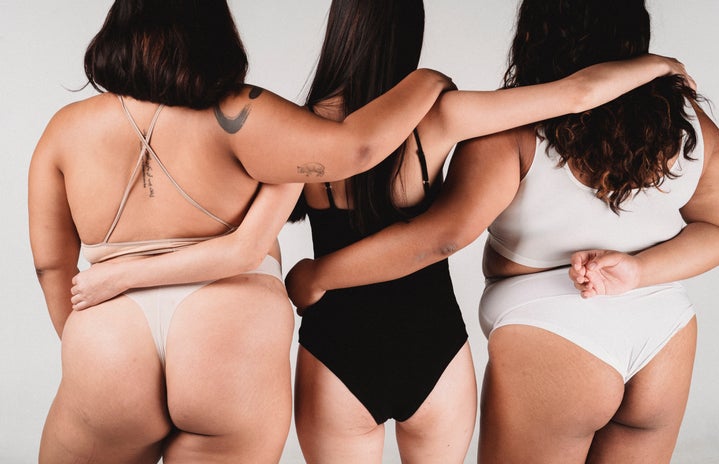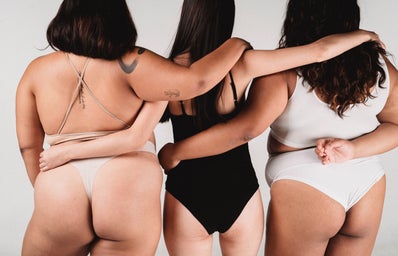This past summer, I went on vacation to Hilton Head Island with my best friend and family. One night, my friend and I decided to go on a long walk on the beach. I told my family where I was going, and before I could even make it to the door, I was told to stop and turn around. One family member eyed me up and down and asked me, “Where do you think you are going dressed like that?” I had just removed my bathing suit underneath my clothes, and I was now wearing denim shorts and a crop top with no bra. As the conversation progressed, I was ridiculed for my decision to go out in public with no bra where my nipples were visible through my shirt. Comments were launched at me such as “You look disgusting,” “I’m ashamed of how you are presenting yourself,” “Who are you trying to impress?,” and “You are asking to be raped.” At that moment, I was overcome with a wave of emotions. I was hurt, ashamed, embarrassed, but most of all, I was frustrated. I decided not to wear a bra not because I was hoping I would attract male attention. I chose not to wear a bra because at that moment it felt uncomfortable to wear one, and this decision is NO WAY an invitation for men to commit non-consensual acts onto me.
This outdated form of logic contributes to victim blaming with the idea that what a woman wears acts as non-verbal consent and or causes the assault she endures. When I choose to wear revealing or tight clothing it is not because I want to be stared at or hit on, it is because what I am wearing makes me look good and feel confident. It took me years to feel confident enough to wear something other than baggy t-shirts and pants, and the moment I feel comfortable enough to express that, I get ridiculed. Why is it hard to believe that women can dress for themselves and not for others? If I did not want to wear a bra that night at the beach after wearing a constricting bathing suit all day, what is the problem with that? If you need to wear a bra and it provides you with comfort, then yes, wear one! However, if a bra only provides you with more discomfort and you don’t feel it’s necessary, then you should not have to. Wearing a bra should be a personal choice and not a social construct.
The problem is not what a woman decides to wear. The problem is blaming women’s clothing choices for the inappropriate thoughts and behaviors of others. During an Irish trial on November 2018, a 27-year-old man was found unanimously not guilty of raping a 17-year-old girl. Part of his defense was that the girl’s lacey thong insinuated that she was open to being with someone and was attracted to the defendant. This argument not only alludes to the false idea that clothing equals consent, but it also suggests that someone’s assumption is more valued than the woman’s own voice. It claims that the actions of the rapist are the fault of the sexual assault survivor–dehumanizing and removing their dignity. Contrary to popular belief, provocative clothing does not lead to higher chances of assault. In fact, one study even found that most convicted rapists cannot even remember what their victims were wearing. The spread of this misconception inhibits women from going out at night or even changing their whole appearance in order to feel safe. It causes women to live in fear and blame themselves for the evil things that happen to them.
Why is this still an issue? Why do I still hear people refer to a woman as a “slut” or a “whore” for wearing a tight dress? Personally, I think this issue stems as far back as elementary school. Throughout the entirety of my primary and secondary education, I conformed with strict dress codes. Theseincluded not being able to wear leggings unless my shirt was covering my butt, shorts could not be any shorter than an inch above my knee, and I could not show my shoulders or collarbone. While I understand that dress codes are applied to maintain a professional work environment, I did not feel this was the only reason. Every year we had school wide assemblies on dress codes in which they emphasized how females must control what they wear to not distract other male students. However, why did we never have assemblies on how to properly treat women and to not overly sexualize their bodies? Instead of teaching men how to control their inappropriate thoughts and actions, we make women cover up. Why? Answer, because it’s easier. It’s easier to make rules for women to follow rather than actually solving the root of the problem.
We need change. We need to educate individuals from a young age how to properly perceive women. When we see a woman wearing revealing clothing, we need to not think, “She is clearly trying to grab someone’s attention” and instead think, “It is amazing she feels confident enough with her body to wear that!” Change doesn’t happen overnight, but with a little bit of mental reframing every day we can see a difference.


